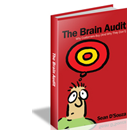You know those presenters who read out from slides? You know how you detest them? Well there's a reason.
And it comes all the way from Hollywood
The Hollywood saying goes like this: If the scene shows you what the scene is supposed to show you, you're in deep shit.
What does that mean?
If there are two lovers over a candlelit dinner and they're saying: “I love you” then the scene is showing you what the scene is showing you.
So in effect it's treating you like an idiot. You already know that the candlelit, soft scene is about love. That's already been clearly shown to you. Now if the actors repeat it, then it's a complete waste of space. And a waste of your time.
Love can be shown in different ways
So in an episode of Frasier, Daphne and Niles are chopping vegetables and singing a song. And they chop to a rhythm. There's love written all over the scene. Unabashed love on Niles' face. Unknown love on Daphne's face. But they never say I love you. They chop veggies.
The same applies to anything whether it goes from cartoons to magazine layouts to presentations
The graphic needs to accompany the text. Not be a replica of the text. If the graphics are a replica of the text, it's boring for the reader/listener/viewer.
So when you read off the points in your slides, you're causing the listener/viewer a ton of grief. For one, you're breaking Hollywood's rule–that's never good. And secondly you're boring me, because here's what happens in my brain.
When I see text, I read it
When I read it, it may appear to be a silent reading but in fact my ear is processing the information before sending it to my brain.
You see this more evidently in older folk and young children. They read aloud so that their ear processes the information before sending it to their brain. The same applies to you and me–except that we don't read aloud. But we've still “read aloud” and then along comes the presenter and reads it aloud again.
That's like saying something twice. That's like saying something twice
It irritates the reader/viewer. It irritates the reader/viewer. And in a few minutes it turns the reader/viewer off completely. And in a few minutes it turns the reader/viewer off completely.
Get the point?
P.S. Do you have a Presentation Story? Share your Story here.
| Product Offers: Links you should visit “I wasn't sure Sean would have anything new to say or would offer |
Top Selling Products Under $50
1) You already know that 80% of a sales letter depends on your headline.
So what's the remaining 20% that causes customers to buy? Find out more
2) Do You Often Hit A Wall Called ‘Writers Block'?
Learn how the core elements of outlining can save you from the misery of writing your next article.
3) Do you know that visuals immediately improve your sales conversion?
Learn how to create drama and curiosity and help improve your web page conversion with visuals.
4) Do your websites, brochures, presentations, etc… confuse your clients?
Put some sanity into your design, even though you are not a designer?
5) Chaos Planning
Year after year you sit down and create a list of things you want to achieve. Then suddenly it's April, and you've not really moved ahead as you'd expected.
Learn Why Most Planning Fails: And The Critical Importance of Chaos in Planning.
NEW PRODUCT! Learn How To make your Presentation stand out from every other presenter.
[next_step]




Hi Sean,
This was clever and insightful, otherwise known as your status quo. I hope to have a presentation story to report back to you next month if my Ignite Minneapolis presentation gets accepted.
20 slides, 15 seconds each, 5 minutes.
That’s all you get and it will force me to read something other than the words on them to engage, entertain, and inspire.
Toastmasters is helping too but what you provide is unique in how it seeps into my brain. Good stuff!
Looking forward to it, Joel 🙂
I agree and disagree here.
Number one, the only thing that matters is testing it both ways.
The good part about reading what they see is the trance inducing effect it causes. If you let their mind wander with too many variables, it’s likely to wander off as well.
So yes…the word for word videos are annoying as hell, especially to marketers…but what does testing show better?
I don’t have an answer for that. I’ve done it both ways though have never run an a/b test on this. Which perhaps I will now 🙂
Good logic behind the argument though.
When you test, I’d want to know what you find, Brad.
If you don’t have enough time, SLOW DOWN!
I was invited to be the sole speaker at a prestigious health policy forum in London, a breakfast meeting for all the big cheeses – Lord this and Lady that.
I had intensively prepared for a 40-minute speaking slot. I usually speak without notes or slides so I knew exactly how I was going to fill the time.
I flew into London from New Zealand late on the eve of the event. It was my first chance to speak with the organisers. “You have 20 minutes to speak tomorrow,” they said.
PANIC!
Then I had a better thought. ‘If if don’t have time to deliver all my speech, I had better SLOW DOWN.’
I realised that I would be more effective if I made sure I really connected with my audience and didn’t try to rush things. It forced me to concentrate on what was really important. I put some pauses in my speech.
When I stood there silent, I was really saying, “Take time to reflect on that point, it’s really important”.
It was one of the best speeches I have made.
My passion is re-humanising healthcare. If you want to know more, read my new book, “TIME TO CARE”
Best wishes, Robin
Yes, I agree. Slowing down has helped me too. Not always, but often enough it lets me bring in the thoughts and of course, it gives the moment some importance 🙂
Sean, it’s even worse than you describe.
1. Adults read much faster than they speak. Which means your audience reads your bullet points in about 10 seconds, while you spend the next 3 minutes reading and commenting on them. Which means your audience spends 2:50 seconds tuned out waiting for you (the presenter !) to ‘catch up’ As you have noted this makes you look stupid (as well as uncaring) because your audience considers themselves ‘ahead of you’ In which case where is your credibility ?
2. Death B y Bullet Points .. or as TX Hammes calls them in this article “Dumb Dumb Bullets” http://www.armedforcesjournal.com/2009/07/4061641 represent lazy thinking and a total and utter disregard for your audience. When you present a heavy bulleted presentation you are saying to your audience “I just can’t be bothered much about this …” No respect.
Here is Dean’s Law about presentation design.
Hard is Easy. Easy is hard.
It is really easy to make it hard for your audience. Create dumb dumb bullets … or cram lots of complicated chart junk and awful clip art on your slide and just leave your first draft presentation as your last. That’s easy … for YOU.
But it takes hard work (by you) to make it easy on your AUDIENCE. You should never, ever, EVER start your presentation by designing slides first. Stay away from Powerpoint/Keynote. Write your script first. Only then, once you know what you want to say, can you design visuals to support those messages. Back to your Hollywood analogy. They write the script first, over many drafts and much work. Only then can they storyboard (sketch the design) and shoot (create the visuals)
Write your script, then think creatively about how to support it. Start with sheets of blank paper and a pencil. Print out your script. Read it and with your pencil , line off the script into separate visuals. When done, number each section as a slide. Take your blank paper and sketch ideas for each section (slide) number each sheet of paper to match the script. Only when you are happy with the script, structure and visual concepts do you start on the computer.
Is this hard work ? Yes it is. That’s why 99.99% of the millions of presentations delivered every day are awful and in fact, self defeating. You would be literally better off to use NONE and just speak your presentation and simply engage with your audience.
If you cannot put in the effort to treat your audience with the respect they deserve and provide proper visuals, just don’t. Because if you do, it only discredits you … and that is usually the OPPOSITE impression you wish to achieve.
This is a great answer 🙂 And thanks for the time. And yes, I agree, the computer is the last place to start. I’ve made that mistake over and over again, despite telling others not to do so.
As a member of a local BNI chapter I get to see a 10 minute presentation almost every week, probably around 48 per year x 5 years = quite a few presentations.
The first presentation I gave was using Powerpoint – nearly a disaster, we only got the stupid electronic s…t to work about a minute before I started. Being new to the game at that stage, if it didn’t work I had no back-up plan. Never again! Never ever again!
I’ve therefore seen a few electronic presentations in BNI over the years, and I’ve seen a few disasters in that time. Some hilarious, like the one where the slides changed about every one to two seconds in an endless (uncontrollable) loop.
If you can’t speak to the audience, grab their attention, connect with them, and give them something without the electronic props – don’t even start.
Having said that I think I may actually use a video for my next 10 minute presentation, but for sure, if the electronics let me down I’ll be ready this time to do the human “connect with the audience” thing.
Well, you have to have a backup system. You can’t just rely on technology. At the Uniqueness Workshop, last week in Campbell, the speakers stopped working for no reason at all. But we went ahead as if nothing happened.
These crazy things happen. We just have to be prepared. 🙂
It’s not so much ‘disconnect’ as not repetition. I will, on occasion, read from slides, but often with a different tempo, for instance. Yesterday, I needed to read from slides, because I was quoting what was on a company’s website. And so I did it by varying the speed (tempo). I read quickly, then slowed down. So even though I was reading, there wasn’t the same equal speed. You can also use loud, soft. Or just stop.
Yes, it may sound like a disconnect, but it’s more like an analogy for what’s on the screen.
E.g. if the slide says: ‘Learning about the DNA of uniqueness,’ the presenter (that’s me) would say something like: ‘Let’s take a drive into this world of DNA, and why it’s important’.
Of course, you’re not using analogies for everything. So you have to tweak the words a bit. Or change the tone. Or the tempo. Or the volume.